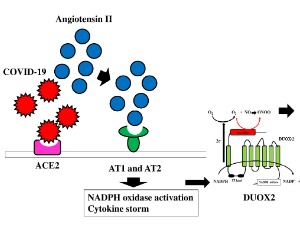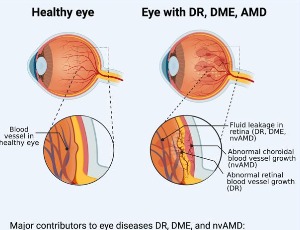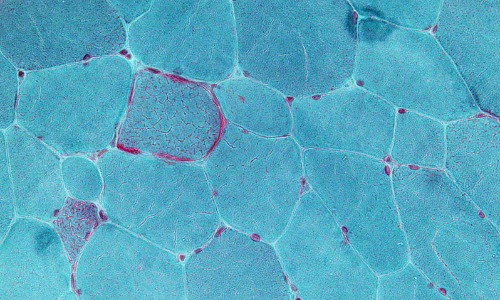Loading
Journal of Cellular Signaling
ISSN: 2692-0638

2021
Volume 2, Issue 2, p85-138
Articles published in this issue are Open Access and licensed under Creative Commons Attribution License (CC BY NC) where the readers can reuse, download, distribute the article in whole or part by mentioning proper credits to the authors.
Effects of a CB2 Subtype Selective Agonist ABK5-1 on Cytokine Production in Microglia
Yaliang Tang, Barbara Wolk, Debra A. Kendall
Neuroinflammation is closely associated with various diseases including neuropathic pain. Microglia are immune cells in the central nervous system which are the main players of immunity and inflammation. Since microglia are activated by nerve injury, and they produce proinflammatory mediators to cause neuropathic pain, targeting activated microglia is considered to be a strategy for treating neuropathic pain.
J Cell Signal, 2021, Volume 2, Issue 2, p85-93 | DOI: 10.33696/Signaling.2.038
Cancer-associated Molecular Abnormalities in Human NK cells
Gulnur K. Zakiryanova, Michael R. Shurin
Cancer is one of the leading causes of death worldwide. The immune system plays an important role in all steps of cancer development, growth and spreading as was repeatedly proven in a variety of experimental and clinical studies. Among the immune cells, Natural Killer cells, or NK cells, are critical to the innate immunity as one of the key effector cells of cancer immunosurveillance.
J Cell Signal, 2021, Volume 2, Issue 2, p94-99 | DOI: 10.33696/Signaling.2.039
Ectodomain Shedding May Play a Pivotal Role in Disease Severity in COVID-19
Rui Yamaguchi, Yasuo Yamaguchi
Ectodomain shedding mediated by a disintegrin and metalloprotease 10/17 (ADAM10/17) modulates the function of immune effector cells and may be involved in the novel coronavirus disease COVID-19. Toll-like receptor 7/8 (TLR7/8) recognizes single-strand RNA from viruses such as severe acute respiratory syndrome coronavirus 2 (SARS-CoV-2, the virus that causes COVID-19) during the innate immune response
J Cell Signal, 2021, Volume 2, Issue 2, p100-102 | DOI: 10.33696/Signaling.2.040
Phosphorylation of RIAM Activates Its Adaptor Function in Mediating Integrin Signaling
Baihao Su, Jinhua Wu
Extracellular matrix (ECM) surrounding cells in solid tissue provides mechanical support and communicates with cells through cell adhesion molecules (CAMs) at the cell surface. Integrin is a major group of CAMs represented by a family of αβ heterodimeric single transmembrane receptors.
J Cell Signal, 2021, Volume 2, Issue 2, p103-110 | DOI: 10.33696/Signaling.2.041
Macrophages in Oral Tissues
Vitor CM Neves, Jing Zhao, Ana J Caetano, Paul T Sharpe
The balance between cell removal following tissue damage and new cell formation to facilitate repair has long been linked to the behaviour of inflammatory macrophages and their interactions with tissue-resident non-immune cells. The main aim of the inflammatory response is to modulate the tissue environment by removing unwanted cells and recruiting cells and soluble factors from the bloodstream to help protect the damaged tissue against infective foreign bodies.
J Cell Signal, 2021, Volume 2, Issue 2, p111-114 | DOI: 10.33696/Signaling.2.042
HGF/MET Signalling and DNA Damage Response: Strategies to Conquer Radiotherapy Resistance in Head and Neck Cancer
Aaran Vijayakumaran, Mahvash Tavassoli
Head and neck squamous cell carcinomas (HNSCCs) are a group of aggressive and genetically complex cancers, derived from the mucosal epithelium in the oral cavity, pharynx, and larynx. Radiotherapy, often combined with chemotherapy remains the mainstay treatment options for patients.
J Cell Signal, 2021, Volume 2, Issue 2, p115-132 | DOI: 10.33696/Signaling.2.043
APE1/Ref-1 as a Novel Target for Retinal Diseases
Curtis Heisel, Jonah Yousif, Mahmut Mijiti, Kostas Charizanis, Mitchel Brigell, Timothy W. Corson, Mark R. Kelley
APE1/Ref-1 (also called Ref-1) has been extensively studied for its role in DNA repair and reduction-oxidation (redox) signaling. The review titled: “The multifunctional APE1 DNA repair-redox signaling protein as a drug target in human disease” by Caston et. al. summarizes the molecular functions of Ref-1 and the role it plays in a number of diseases, with a specific focus on various types of cancer.
J Cell Signal, 2021, Volume 2, Issue 2, p133-138 | DOI: 10.33696/Signaling.2.044
Recommended Articles
Prevalence of Symptom Clusters in Cancer Patients at First Presentation in Palliative Care Clinic as per Different Disease Groups
Cancer has its own disease burden and patients usually suffer from symptom clusters when they are referred for palliative treatment. Identification of symptom cluster trajectories will help clinician to take into account measures that can optimize quality of life of palliative patients. Therefore the aim of this paper is to determine the overall prevalence of symptoms and symptoms clusters in different disease groups according to etiology at the time of first visit to Palliative care clinic by using HIS Palliative First Assessment note indicating Edmonton symptom scale.
Chimeric Antigen Receptor CAR NK Cells Emerging Immunotherapy for the Treatment of Cancer
Although NK cells are recognized as effector lymphocytes of the innate immune system, they also regulate the adaptive immune response by releasing inflammatory cytokines and developing immunological memory. Unlike other lymphocytes such as T or B cells, NK cells do not express rearrangeable, antigen-specific receptors.
pMB FLASH - Status and Perspectives of Combining Proton Minibeam with FLASH Radiotherapy
Proton minibeam radiotherapy (pMBRT) is an external beam radiotherapy method with reduced side effects by taking advantage of spatial fractionation in the normal tissue. Due to scattering, the delivered small beams widen in the tissue ensuring a homogeneous dose distribution in the tumor. In this review, the physical and biological principles regarding dose distribution and healing effects are explained. In the last decade, several preclinical studies have been conducted addressing normal tissue sparing and tumor control in-vitro and in-vivo, using human skin tissue and mouse or rat models. The major results acquired in these studies are summarized. A further newly emerging therapy method is FLASH radiotherapy, i.e. the treatment using ultra-high dose rates. The possibility of combining these methods in proton minibeam FLASH therapy (pMB FLASH) is worked out. Additionally, technical feasibility and limitations will be discussed by looking at simulations as well as preclinical studies and also pointing out new ways of delivering the desired tumor dose, such as interlacing. We will also highlight the opportunities that emerge regarding high dose radiation, hypofractionation and the combination with immunotherapy.
Emerging Role of TRPML1 Mucolipin Endolysosomal Channel in Cancer
The transient receptor potential mucolipin 1 (TRPML1) is an endolysosomal channel belonging to the TRP family. Clinically, mutations of TRPML1 have been responsible for a severe lysosomal storage disorder called mucolipidosis type IV.
COVID-19 Clinical Research
While the global COVID-19 pandemic has challenged the entire humanity and health systems, it also triggered researchers to urgently perform clinical trials to assess the safety and efficacy of many agents and modalities to combat COVID-19. As of April 22, over 650 clinical studies have been registered both in USA and internationally. Results from these studies are also coming at a brisk pace in this unprecedented emergency.
Macular Microcirculation after Rhegmatogenous Retinal Detachment Repair Evaluated by OCT-Angiography
In the process of rhegmatogenous retinal detachment (RRD), retinal homeostasis may be adversely affected with resultant modifications in retinal and choroidal tissue. Hypoxia and nutrient deprivation along with inflammation at the detached retina may lead to morphological and microvascularity alterations. These changes imply that the functional status of the macula may not be entirely restored despite anatomical repair.
Therapeutic Values of Ketamine for COVID-19-Cared Patients: An Expert’s Point of View
Ketamine has long been used in the field of anesthesia [1]. Its rapid and long-acting analgesic effects associated with its dissociative properties have also established its use in prehospital and emergency department patients.
Focal Aggregates of Normal or Near Normal Uveal Melanocytes (FANNUMs) in the Choroid. A Practical Clinical Category of Small Ophthalmoscopically Evident Discrete Melanocytic Choroidal Lesions
Multiple types of discrete melanocytic choroidal lesions are currently recognized, including benign choroidal nevi, choroidal malignant melanomas, patches of choroidal melanocytosis, and foci of choroidal melanocytes stimulated paraneoplastically by a systemic nonmelanoma malignant neoplasm.
Uniportal VATS Lobectomy for Lung Cancer: Feasibility and Cost Effectiveness in a Single Center Experience
In last decades, video-assisted thoracic surgery (VATS) together with robotic-assisted thoracic surgery (RATS) can be considered the biggest innovation in thoracic surgery. This approach drastically changed the way of performing surgical operations, improving patient’s outcome undergoing thoracic surgery.
A Bioinformatics Protocol for Rational Design of Peptide Vaccines and the COVID-19 Rampage
The currently ongoing coronavirus pandemic, the SARSCOV- 2, interchangeably referred to as the COVID-19 infection, has in a short span of time altered the ways and means of almost all of mankind. So strong has been its effect that all human activity ceased in one way or another for a considerable time, led to significant loss of life and economic drain of.
Circulating Cell-Free RNA: A New Perspective for Endometrial Cancer
In order to implement the knowledge of cancer to monitor its evolution and setting, in the last decade, new minimally invasive and repeatable samples collection have been developed such as liquid biopsy.
Searching for Easy Reliable Prognostic Parametres in Colorectal Cancer Patients Evaluation
Despite the advances in diagnostic and therapeutic field, colorectal cancer (CRC) still remains the third most common cause of death worldwide, with more than 600,000 cancer-related deaths per year.
Multidisciplinary Acute Care of Central Retinal Artery Occlusion with a Stroke Paradigm: A Call to Action
Central retinal artery occlusion (CRAO) is a painless ophthalmologic emergency with potential for irreversible vision loss. Similar to ischemic stroke, CRAO occurs when there is sudden obstruction of the central retinal artery, leading to ischemic injury to the retina and subsequent cell death. Continuous occlusion and ischemia of the retina progresses to permanent damage to retinal cells and loss of vision.
Lessons Learnt from COVID-19: How Can We Prepare for Another Pandemic?
Five months into the COVID-19 pandemic, the U.S. death toll from the virus has now surpassed 100,000 people. Many more cases remain nationwide, while an unknown number of patients currently harbor the virus asymptomatically. While health officials are now optimistic regarding the decline in prevalence and number of deaths due to COVID-19 and the possibility of a vaccine by the fall, we cannot lose sight of the bigger picture: the next pandemic.
Safety of Using Rituximab Therapy During COVID-19 Pandemic
Rituximab is a chimeric (20% rodent and 80% human) monoclonal antibody that binds to the CD20 antigen present on the cell surface and leads to depletion of mature B-cells [1,2]. It is the first approved monoclonal antibody to be used in the therapy of indolent B-cell non- Hodgkin’s lymphoma and chronic lymphocytic leukemia
Deubiquitinase as Potential Targets for Cancer Immunotherapy
During the last few decades, immunotherapy is considered to be an important approach to help our immune system to fight various kinds of diseases, such as tumor. Sometimes, it works very well for some types of cancers, for example: bladder cancer, colorectal cancer, breast cancer and lymphoma.
The Effect of Glucocorticoids on Angiogenesis in the Treatment of Solid Tumors
Glucocorticoids (GCs) are defined by their role in maintaining glucose homeostasis and natural GCs are a class of corticosteroids secreted by the adrenal cortex. Cortisol is the most important natural GC in humans. Cellular cortisol levels are regulated by the tissue-specific metabolic enzymes 11β-hydroxysteroid dehydrogenase 1 and 2 (11β-HSD 1 and 2); 11β-HSD 1 converts inactive cortisone to active cortisol, while 11β-HSD 2 has the opposite function.
Distinct Phosphorylation of STAT1 Confers Distinct DNA Binding and Gene-regulatory Properties
Signal transducer and activator of transcription 1 (STAT1) protein plays a pivotal role in various biological processes especially the regulation of innate and adaptive immune responses. Phosphorylation represents a key step in the activation of STAT1 and its transcriptional outcome. Binding of various extracellular ligands to their specific cell-surface receptors activates different phosphorylation of STAT1 followed by a distinct change of gene expression patterns.
Educators as Essential Workers in the Era of COVID-19: Applying Lessons from Disaster Recovery
In the article, “Mental Health Framework: Coronavirus pandemic in post-Katrina New Orleans” [1], Shervington and Richardson offer recommendations about how to anticipate and address disaster-related, trauma exposures associated with the coronavirus pandemic
How Well Do Hemodialysis Patients Respond to the BNT162b2 mRNA COVID-19 Vaccine?
In January 2020, the World Health Organization (WHO) classified COVID-19 to be a Public Health Emergency of International Concern and declared it a pandemic on March 11, 2020 [1]. Over one hundred and eighty-five million people have been infected by SARS-CoV-2 and roughly four million have died worldwide so far
Trending Special Issues
About Scientific Archives
Scientific Archives is a global publisher initiated with the mission of ensuring equal opportunity for accessing science to research community all over the world. Spreading research findings with great relevance to all channels without any barrier is our goal. We want to overcome the challenges of Open Access with ensured quality and transparency.


